General
- Do not place products in places where condensation is present and can fall on the product. Preferably do not place products under the evaporators.
- Use clean pallets, remove protruding nails or splinters. Do not use broken pallets (unsafe).
- Do not place pallets with products completely against the wall (at least 10 cm space) to enable cleaning and pest control.
- Keep cold store and freezer doors closed as much as possible to prevent temperature fluctuations.
- Defrost products in the cold store.
- Ensure that raw materials and finished products are always stored separately from each other so as to minimise confusion/cross-contamination with allergens or microbiological and physical contamination.
- Place allergens at the bottom of the rack or separately, if possible.
- Products or semi-finished products which are stored intermediately and are not protected are covered. Material that is clearly distinguishable (for example plastic) is used for this.
- Damaged packaging is closed and wet or dirty packaging is blocked.
- Packagings are folded or rolled after use.
- Foodstuffs or crates of foodstuffs never stand directly on the ground, but on a clean trolley, on a pallet or on another empty crate.
- Store all raw materials, semi-manufactured products, finished products and packaging materials according to the FIFO (First-In First-Out) or FEFO (First Expired First Out) method using the best before/ used by date. This means: storing products with a shorter shelf life on or before products with a longer shelf life. In practice, this means: when making a new delivery, placing the products already present (usually with a shorter shelf life) on or in front of the products that have just been delivered. When putting into use, use the product with the shortest Best before/ use by.
- Products must always be identifiable and traceable.
Storage of raw materials
- Check the raw materials for broken packaging, other foreign materials, or traces of vermin.
- If there is a suspicion of tampering (food defense), inform the manager immediately.
- Label the pallets with the date of arrival, consignment note number, sampling, and release.
- Place the pallet in the right place in the rack and store it under the right conditions. Be aware of the risk of allergens being carried over. Keep enough space in between. Avoid cross-contamination when opening packages and weighing. Make sure that identification and traceability is guaranteed when packaging is opened.
- Make sure that the raw materials are stored in FIFO (First In First Out).
- Check the expiration date of the products. Block and set aside if exceeded and report to the manager.
Storage of finished product
- Provide the pallet with an A4 sheet with the name of the product, the best before date, and the quantity.
- Check the products for broken packaging, other foreign material, or traces of vermin.
- If there is a suspicion of tampering (food defense), inform the manager immediately.
- Place the products in the correct rack and store the product under the right conditions. Take into account cross-contamination and carry-over of allergens if packaging is damaged.
- Make sure that the oldest products are delivered first.
- Ensure that identification and traceability is safeguarded throughout the storage period.
Storage of semi-finished products
- Identification and traceability: Ensure that the semi-finished product is identified (label).
- Store in the right place and under the right conditions.
- Prevent cross-contamination (including pollution, allergens) by properly covering the semi-finished product.
Related articles to What to consider when storing the products?
Many customers and visitors to this page 'What to consider when storing the products?' also viewed the articles and manuals listed below:



